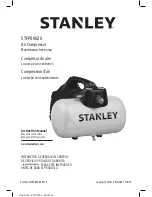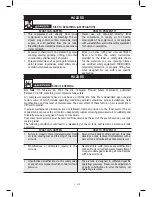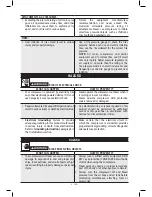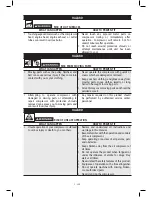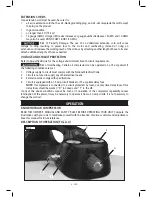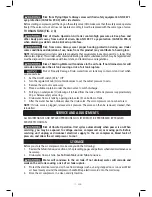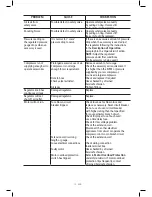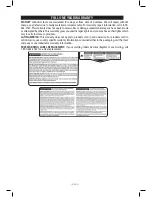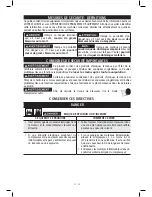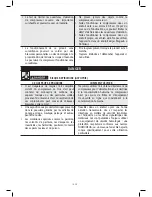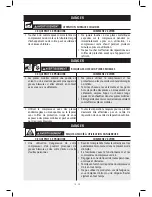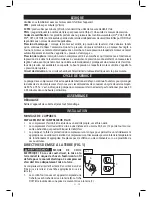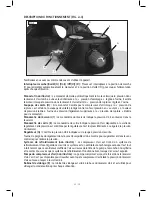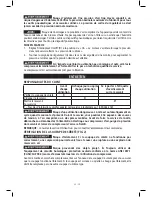
11 - ENG
Risk from Flying Objects. Always wear certified safety equipment: ANSI Z87.1
eye protection (CAN/CSA Z94.3) with side shields.
Before starting compressor, pull the ring on the safety valve (H) to make sure that the safety valve operates
freely. If the valve is stuck or does not operate smoothly, it must be replaced with the same type of valve.
TO DRAIN TANK (FIG. 2, 3)
Risk of Unsafe Operation. Air tanks contain high pressure air. Keep face and
other body parts away from outlet of drain. Use ANSI Z87.1 eye protection (CAN/CSA Z94.3)
when draining as debris can be kicked up into face.
Risk from noise. Always wear proper hearing protection during use. Under
some conditions and duration of use, noise from this product may contribute to hearing loss.
NOTE:
All compressed air systems generate condensate that accumulates in any drain point (e.g., tanks, filter,
aftercoolers, dryers). This condensate contains lubricating oil and/or substances which may be regulated and
must be disposed of in accordance with local, state, and federal laws and regulations.
Risk of Bursting. Water will condense in the air tank. If not drained, water will
corrode and weaken the air tank causing a risk of air tank rupture.
Risk of Property Damage. Drain water from air tank may contain oil and rust which
can cause stains.
1. Set the On/Off switch (D) to "Off".
2. Turn the regulator knob (G) counterclockwise to set the outlet pressure to zero.
3. Remove the air tool or accessory.
4. Place a suitable container under the drain valve to catch discharge.
5. Pull ring on safety valve (H) allowing air to bleed from the tank until tank pressure is approximately
20 psi. Release safety valve ring.
6. Drain water from air tank by opening drain valve (K) on bottom of tank.
7. After the water has been drained, close the drain valve. The air compressor can now be stored.
NOTE:
If drain valve is plugged, release all air pressure. The valve can then be removed, cleaned, then
reinstalled.
SERVICE AND ADJUSTMENTS
ALL MAINTENANCE AND REPAIR OPERATIONS NOT LISTED MUST BE PERFORMED BY TRAINED
SERVICE TECHNICIAN.
Risk of Unsafe Operation. Unit cycles automatically when power is on. When
servicing, you may be exposed to voltage sources, compressed air, or moving parts. Before
servicing unit unplug or disconnect electrical supply to the air compressor, bleed tank of
pressure, and allow the air compressor to cool.
STORAGE
Before you store the air compressor, make sure you do the following:
1. Review the
Maintenance
section on the preceding pages and perform scheduled maintenance as
necessary.
2. Drain water from air tank. See
To Drain Tank
under
Maintenance
.
Water will condense in the air tank. If not drained, water will corrode and
weaken the air tank causing a risk of air tank rupture.
3. Protect the electrical cord and air hose from damage (such as being stepped on or run over). Wind
air hose loosely around the compressor handle. Wrap electrical cord onto the cord wrap.
4. Store the air compressor in a clean and dry location.
Summary of Contents for STFP00020
Page 43: ...43...

